Introduction: This and future blogs are intended to provide information to persons in the live entertainment industry to enhance their technical knowledge and provide a better understanding relating to many electrical aspects of equipment, wiring and safety.
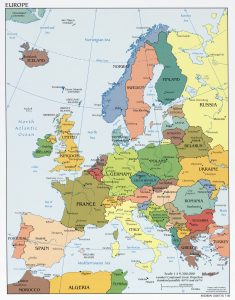
Disclaimer: Although the vast majority, of the information provided, is indisputable, there are cases where some of the information is “open to interpretation”, especially in the area of International Electrical Codes.
In such cases the “final say” is up to the local “Authority Having Jurisdiction” (AHJ). Much of the information provided is based on IEC Standards, however, these requirements may be accepted as written or modified by local authorities (by law), especially in large cities and various countries.
This information does not necessarily represent the opinion of the editorial board or Motion Labs and its owners.
There are various agencies, governmental bodies and authorities having jurisdiction that must be dealt with when bringing equipment into and for use in Europe. Below is a description of some of these entities and the interaction among them.
The European Union (EU):
A political and economic union of 28 member states that are located primarily in Europe. The EU has developed an internal single market through a standardized system of laws that apply in all member states. EU policies aim to ensure the free movement of people, goods, services and capital within the internal market, enact legislation in justice and home affairs and maintain common policies on trade.
Countries in the EU:
Austria, Belgium, Bulgaria, Croatia, Republic of Cyprus, Czech Republic, Denmark, Estonia, Finland, France, Germany, Greece, Hungary, Ireland, Italy, Latvia, Lithuania, Luxembourg, Malta, Netherlands, Poland, Portugal, Romania, Slovakia, Slovenia, Spain, Sweden and the United Kingdom.
(Note: At the time of this writing it is questionable if all the countries, listed above, will remain in the EU. This should have little effect on compliance with IEC standards or CE requirements.)
International Electrotechnical Commission (IEC):
The world’s leading organization that prepares and publishes International Standards for all electrical, electronic and related technologies.
In the United States, Underwriters Laboratories, Inc. (UL) standards are predominant, while in Europe most UL standards and listings have little or no relevance. The IEC and UL have harmonized some of their standards, but most UL standards are not acceptable on the other side of the pond.
Other countries, around the world, may use different standards, so be aware.
Conformité Européenne (CE), meaning European Conformity:
By affixing the CE marking to a product, a manufacturer declares that the product meets all the legal requirements and directives for CE marking and can be sold and used throughout the European Economic Area (EEA). This also applies to products made in other countries that are sold or used in the EEA.
A directive is a legal act of the European Union, which requires member states to achieve a result without dictating the means of achieving that result.
CE marking is a self-certification scheme. Manufacturers and retailers sometimes refer to products as “CE approved”, but the mark does not actually signify approval. Certain categories of products require testing by an independent body to ensure conformity with relevant technical standards, but CE marking does not necessarily certify that this has been done.

There is some confusion as to the meaning of the term “Self-Certification”. This certification must be backed-up by test data. This testing is based on the requirements of a vast number of standards (Predominately IEC).
So, CE “self-certification” does not mean products brought into the EU are certified, just because you (or the manufacturer) say they are. You must have test data, usually provided by a third party, and a declaration of conformity (DoC),.
Port of entry inspectors will look for the CE mark and may ask for test data documentation prior to off-loading your equipment. If you happen to get lucky and you make it to the venue you will encounter more inspectors.
The local authorities take this stuff seriously. You may get away with it, but do you want to spend tens of thousands of dollars on shipping costs on a “hunch” you can use your equipment?
We say: “The show must go on”; They say: “The show must NOT go on”.
Power is not the same in all locations of the EU. It is extremely important to know what you’re getting into,
especially if you’re touring thru several countries. The “standard” power configurations are explicated hereunder, but nothing is written in stone. Check with a technician or electrician in the actual venue (prior to going there with your equipment), to verify the electrical supply parameters.
Voltage:
For many years, mainland Western Europe has used a mains electricity supply rated 220/380VAC.
The UK used 240/415VAC
Currently, ALL Western European supplies are classified 230/400VAC. In reality, there is no 230/400VAC supply unless you create one locally. 230/400VAC was a “standard” created during European “harmonization” to give a single voltage standard across Western Europe, including UK and Irish Republic.
Although the ideal would have been to have a single voltage, there were too many political, financial and technical obstacles to reduce UK voltage to European levels or to increase European voltage to UK levels, so a new standard was created to cover both. This was achieved by changing the tolerances of previously existing supply standards. UK voltage is 240VAC + 6% and – 10% and European is 220VAC +10% and -6% (thereby creating a manageable overlap) and we would call these two combined 230/400VAC, despite the fact that nobody was intentionally generating at 230/400VAC.
Depending on the voltage sensitivity of your equipment and the variance from nominal of the actual supplied voltage, it may not be advisable to use a 220/380VAC specific device in the UK, or a 240/415VAC specific device in Mainland Europe. For instance, a 240/415VAC supply can rise to as high as 254.4/508.8VAC and still be within tolerance. A 220/380VAC supply can drop as low as 206.8/357.2VAC and still be within tolerance. This could be outside the specification of the equipment with obvious implications. A 230/400VAC (CE marked) product must be compatible with all voltages across this tolerance range.
Frequency (Hz):
The standard frequency in Europe is 50Hz. Does all your equipment operate at 50Hz?
Transformers can change the voltage but they do not change the frequency. In addition, you may be hard pressed to find a European generator that outputs 60Hz.
Most modern electronic equipment will tolerate variations in both voltage and frequency, but some equipment won’t. Check each piece of equipment that you plan to use; the frequency requirement is marked (usually near the input power cord). If it doesn’t say 50/60HZ, you may be in trouble; you can also check with the manufacturer, to see if it will work at 50Hz.
Some “direct connected” motors will run at 50 or 60HZ, but a motor will generally run slower (and perhaps hotter) at 50Hz compared to 60Hz. Variable frequency drive hoists can compensate, however, all components in the system must be compatible.
Load Amperage:
You need to know the total load of your equipment (in amperes), in order to procure a transformer or generator with adequate capacity. KVA is the unit of measurement of transformer power. KVA is dependent on volts, amps and reactance. Due to the complexity of determining KVA, it is suggested that you consult your equipment supplier to calculate the size of the transformer or generator required.
Transformers:
A transformer is the device used for changing voltage. Remember what was stated above regarding frequency “Transformers do not change frequency”. Transformers must be marked 50Hz or 50/60Hz.
Transformers marked 60HZ (only) cannot be used on 50Hz systems, due to excessive heating.
The normal voltage change is from 380VAC to 120/208VAC or from 415VAC to 120/208VAC. Therefore, it is best to purchase a transformer that has multiple primary taps, so it can be used on various voltage inputs (as described in the “voltage” section, above).
Generators:
Much like in the U.S., generators are used to a large extent for live shows in Europe. There may be a big problem however. European generators usually output European voltages at 50Hz.
Unless you can procure a generator with the proper voltage, the normal fix is to run generator power to a transformer for voltage correction. Once again, this does not change frequency.
Color Codes:
North American and European wiring color codes are different. It may sound like an area to be taken lightly … but it’s not. If you are not allowed to use your PD because it has the wrong color cam connectors… then what.
We discussed “CE Marking” above, guess what…. You can’t have a CE mark on equipment with North American color-coded cam connectors.
The color codes are defined below:
North America: (120/208VAC) Green=Ground; White=Neutral; Black=L1; Red=L2; Blue=L3
Europe: (All voltages) Green/Yellow=Ground; Blue=Neutral; Brown=L1; Black=L2; Gray=L3
So, you can see where you might get into trouble. The IEC or CE does not give exemptions to use North American color codes in Europe, you must follow their codes. Internal (inaccessible) wiring is not part of the European color code requirements, as far as external stage connections go.
Feeder Connectors:
What we’re talking about here is technically termed “Single Pole Separable Connectors”, commonly referred to as “Cam-Loks”. Although the term “Cam-Lok” is used generically, it is actually a brand name owned by Crouse-Hinds, a division of Eaton.
The original version, which is also the most common in North America, is not allowed in Europe.
IEC/CE requires that no portion of a live conductor be accessible during connection or removal (finger safe).
The original version of Cam-Loks do not comply with this mandate, in addition a spring-loaded door
(on a feed-thru Cam receptacle) does not comply with the requirement either.
Cam-Lok with N.A. Color Code
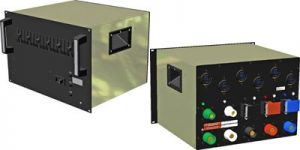
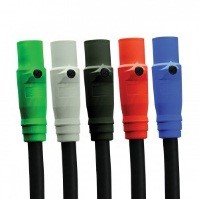
Power-Safe with EU Color Code
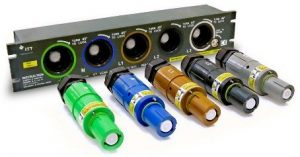
There have been advances in Single Pole Separable Connectors, that are “finger safe” and comply with IEC/CE requirements. One of the most popular and industry accepted is termed “Power-Safe”.
Power-Safe connectors are “keyed” and color coded for proper mating. IEC/CE color codes still apply.
Keep in mind that Power-Safe connectors do not mate with Cam-Loks.
Pin & Sleeve connectors:
Pin & Sleeve connectors are acceptable in both North America and Europe (If listed that way). These connectors are multipole (Single phase or three phase), and can be used for connection of main & sub feeders and branch circuits. They are keyed, sized and color coded by voltage and amperage.
The big disadvantage is that the maximum amperage is 125A, which limits their use for main feeder connections. There are larger ones, but due to their size they are unmanageable, impractical and may be cost prohibitive.
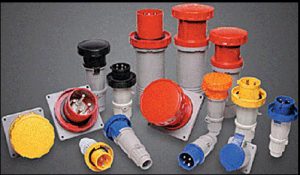
Circuit Breakers:
Standard European branch circuit breakers are rated slightly different than their North American counterparts.
Standard amperages include: 16A, 32A, 63A and 125A. Standard North American circuit breakers may be acceptable in Europe (if sized properly), but must have a CE approval. PDs with a CE mark implies that the internal circuit breakers comply with IEC/CE requirements, however it’s a good idea to get “back-up” information from the PD manufacturer regarding CE acceptance.
Input/output Devices:
Plugs and receptacles, such as Edison, Twist-Locks and Stage Pin do not comply with the “finger-safe” requirement and are not allowed unless they are “shrouded” or incorporate other methods that prevent accidental contact with the energized prongs.
Neutrik PowerCon and IEC connectors (like on the back of your computer) comply with the “finger-safe” requirement, however the is no voltage specified, other than a maximum of 250VAC. There may be restrictions for their use due to misapplication of the connection of load equipment. These devices are normally used for both 120VAC (Line & Neutral in North America) and 240VAC (line & Neutral in Europe).
Neutrik PowerCon IEC Inlet / Outlet Combo
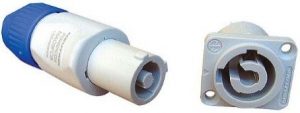
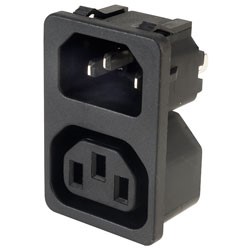
RCD/GFCI:
RCDs (Residual Current Detector) and GFCIs (Ground Fault Circuit Interrupter) are functionally similar.
In North America GFCIs are not usually required for live productions, in Europe, however, RCDs are required.
GFCIs trip around 5ma, which may “nuisance trip”; Some RCDs have adjustable trip points up to 30ma, which is a good balance between nuisance tripping and safety.
North American GFCI RCD Circuit Breaker RCD Remote Contactor Control
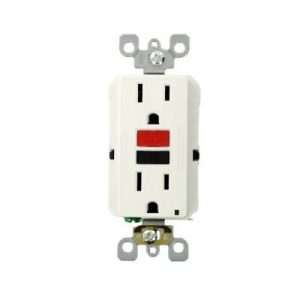
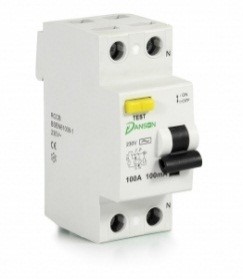
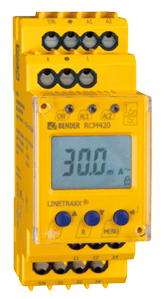
Labeling & Warning marking (language):
Some jurisdictions require that labeling and equipment warnings be in the language of the location where the equipment is used. This is not always required, but you better check.
Health & safety:
In Great Britain, the Health and Safety at Work, Act 1974 (also referred to as HASAWA) is the primary piece of legislation covering occupational health and safety. The Health and Safety Executive, with local authorities (and other enforcing authorities) is responsible for enforcing the Act and several other Acts and Statutory Instruments relevant to the working environment.
This is comparable to the Occupational Safety and Health Administration (OSHA) in the United States.
Conforming to the requirements set forth in this Act is mandatory, and is probably something you’re not familiar with. It may be advisable to hire a local consultant, in the UK, for assistance.
There is a myriad of forms, labor regulations and risk assessment evaluations that must be completed, prior to production of a live entertainment show, in addition to local and/or venue rules that must be complied with.
One of the best reference books is: “Health and Safety Management in The Live Music and Events Industry”, by Chris Hannam (Published by:” Entertainment Technology Press”).
Chris may be contacted directly: info@stagesafe.co.uk .
Note: Motion Labs has no direct business connection with neither “Stage-Safe” nor “Chris Hannam”. This information is provided for reference only.
Conclusion:
The opinion, expressed herein, is only a personal interpretation. Check with your local authorities for final decisions on code matters. If you’re not absolutely sure of what you’re doing, consult a local electrical or production professional.
Motion Labs is here to help.
We encourage you to ask questions, provide constructive criticism, and suggest subjects for future blogs.
Remember some of the subject matter may be argumentative in nature. If you disagree or need clarification, let us know.
Thanks:
Jim Herrick
About the author:
Jim Herrick, over 40 years’ experience in the electrical field. Licensed in the State of New Jersey as an Electrical Contractor (License #6748) and Electrical Inspector (License #7702). Of the 40 years’ experience, 30 of which, included work in the theatrical industry, which also included electrical equipment design for major companies in the industry.




Leave a Reply